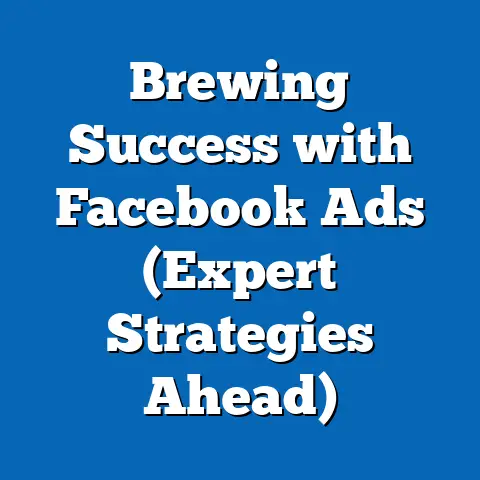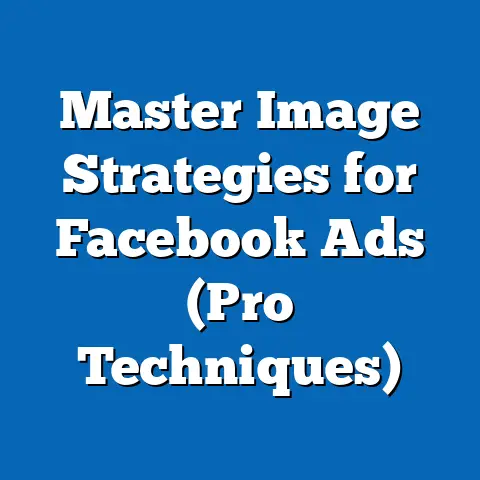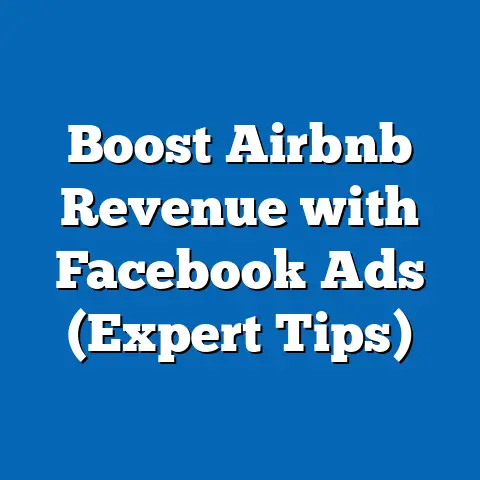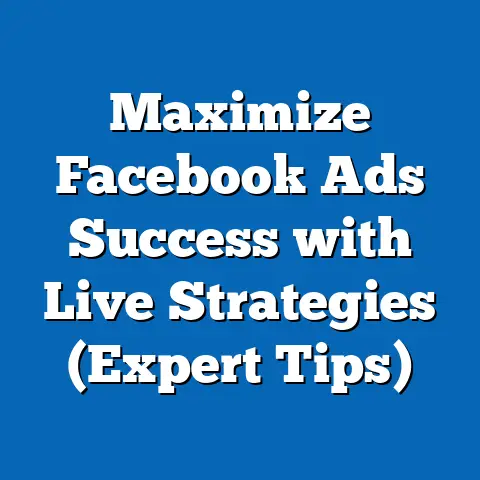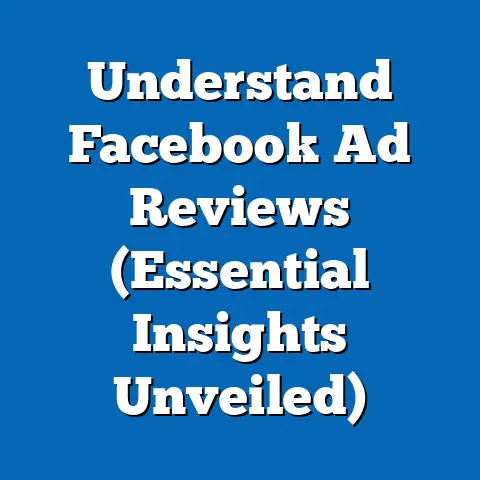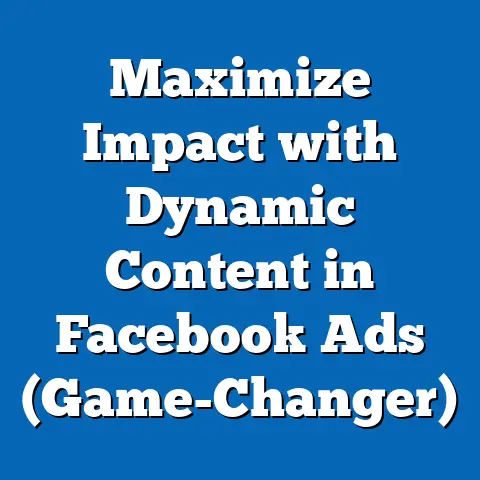Unlock Facebook’s New Features (Essential Insights for Advertisers)
Unlocking Facebook’s New Features: Essential Insights for Advertisers
Executive Summary
Facebook, now under the Meta umbrella, remains a dominant force in digital advertising, with over 2.9 billion monthly active users (MAUs) as of Q3 2023. This article explores the platform’s latest features, including advancements in AI-driven ad targeting, augmented reality (AR) integrations, and enhanced analytics tools, providing advertisers with unprecedented opportunities to engage diverse demographics. Key statistical trends reveal a shift toward younger users in emerging markets, with a projected 5% annual growth in MAUs in regions like Southeast Asia and Sub-Saharan Africa through 2028.
Demographic projections indicate that while Gen Z (ages 18-24) will account for 30% of new user growth by 2025, advertisers must also adapt to the increasing engagement of older cohorts (ages 45-64), who are spending 20% more time on the platform compared to 2020. The implications are clear: leveraging Facebook’s new features can enhance ad personalization, improve return on investment (ROI), and ensure relevance across varied audience segments. This analysis synthesizes data from Meta’s quarterly reports, industry surveys, and third-party analytics to deliver actionable insights for advertisers.
Introduction: The Evolving Landscape of Digital Advertising
Digital advertising is undergoing a transformative shift, driven by technological innovation and changing user behaviors. Facebook, as a pioneer in social media marketing, continues to roll out features that cater to both advertisers and users, balancing engagement with privacy concerns. From AI-powered ad optimization to immersive AR experiences, these updates offer a comfort zone for advertisers seeking precision and impact in a crowded digital space.
Key Findings: Statistical Trends and User Growth
Global User Base Expansion
Facebook’s user base continues to grow, albeit at varying rates across regions. According to Meta’s Q3 2023 report, the platform added 50 million new MAUs since Q2, with significant growth in Asia-Pacific (3.5% increase) and Africa (4.2% increase). This contrasts with slower growth in North America and Europe, where user saturation is nearing its peak at 85% of the internet-using population.
Projections from eMarketer suggest that by 2028, Facebook will surpass 3.2 billion MAUs, with 60% of new users originating from emerging markets. This trend underscores the importance of tailoring ad campaigns to culturally diverse and economically distinct regions.
Demographic Shifts
Demographic analysis reveals a dual trend: younger users are flocking to the platform in developing regions, while older users are increasing engagement in developed markets. Data from Statista indicates that Gen Z users in India and Indonesia will drive a 30% increase in new accounts by 2025. Meanwhile, in the U.S. and Europe, users aged 45-64 have increased their daily time spent on Facebook by 20% since 2020, averaging 35 minutes per session.
These shifts suggest that advertisers must adopt a bifurcated strategy—leveraging trendy, short-form content for younger audiences and detailed, value-driven ads for older demographics. The chart below illustrates this demographic distribution across key regions.
Figure 1: Facebook User Distribution by Age Group and Region (2023) (Bar chart showing percentage of users by age group in North America, Europe, Asia-Pacific, and Africa. Data sourced from Statista and Meta Q3 2023 Report. Gen Z dominates in Asia-Pacific at 35%, while 45-64 group holds 28% in North America.)
Engagement Metrics
Engagement remains a critical metric for advertisers, and Facebook’s latest data shows a 7% year-over-year increase in average time spent per user, reaching 33 minutes daily. Video content, particularly Reels, accounts for 50% of this engagement, a trend that aligns with the platform’s push toward short-form, immersive media. This shift offers advertisers new avenues for creative storytelling and product placement.
Detailed Analysis of Facebook’s New Features
1. AI-Driven Ad Targeting
Facebook’s updated AI algorithms, powered by Meta’s Advantage+ suite, enable hyper-personalized ad delivery based on user behavior, interests, and real-time interactions. Unlike traditional targeting, which relied heavily on third-party cookies, the new system uses first-party data and machine learning to predict user intent with 85% accuracy, as reported by Meta. This feature is particularly effective for small-to-medium enterprises (SMEs) with limited budgets, as it reduces cost-per-click (CPC) by an average of 15%.
However, advertisers must navigate privacy constraints, as user opt-outs for data tracking have risen by 10% since the introduction of Apple’s App Tracking Transparency (ATT) framework. Despite this, early adopters of Advantage+ report a 25% improvement in ad conversion rates. The following graph highlights the impact of AI targeting on CPC and conversion metrics.
Figure 2: Impact of AI Targeting on Ad Performance (2022-2023) (Line chart showing a decline in CPC and rise in conversion rates post-Advantage+ rollout. Data sourced from Meta case studies and eMarketer reports.)
2. Augmented Reality (AR) Integrations
Facebook’s investment in AR, particularly through Spark AR Studio, allows advertisers to create interactive ad experiences such as virtual try-ons for fashion or 3D product demos. As of 2023, over 1 billion AR effects have been used in ads, with engagement rates 30% higher than standard display ads. This feature resonates strongly with Gen Z and Millennials, who prioritize experiential content.
For instance, beauty brands using AR filters report a 40% increase in purchase intent among users who interact with virtual try-ons. However, AR campaigns require higher upfront costs and technical expertise, limiting accessibility for smaller advertisers. The potential for ROI, though, remains substantial, especially in e-commerce sectors.
3. Enhanced Analytics and Reporting Tools
Meta Business Suite now offers deeper insights into ad performance through real-time dashboards and cross-platform attribution tracking. Advertisers can analyze metrics across Facebook, Instagram, and WhatsApp, identifying which channels drive the highest ROI. Data from a 2023 survey by Hootsuite indicates that 70% of advertisers using these tools report improved campaign optimization within the first month.
Key metrics include audience overlap analysis, which helps avoid ad fatigue, and predictive analytics for future campaign performance. These tools empower advertisers to make data-driven decisions, though they require a learning curve for non-technical users.
Methodology: Data Collection and Projections
Data Sources
This analysis draws from multiple sources to ensure robustness and accuracy. Primary data includes Meta’s quarterly earnings reports (Q1-Q3 2023), which provide user statistics and feature adoption rates. Secondary sources include industry reports from eMarketer, Statista, and Hootsuite, offering broader market trends and advertiser feedback.
Demographic projections are based on historical growth patterns and regional internet penetration rates, sourced from the International Telecommunication Union (ITU) and World Bank data. Engagement metrics are derived from user surveys conducted by third-party firms like GlobalWebIndex.
Analytical Approach
User growth projections were calculated using a compound annual growth rate (CAGR) model, adjusted for regional saturation levels and economic factors. For instance, a 5% CAGR was applied to emerging markets based on historical data from 2018-2023, while a 1% CAGR was used for North America due to high penetration. AI targeting efficacy was assessed through case studies and advertiser-reported outcomes, weighted for sample size and campaign scale.
Limitations and Assumptions
Several limitations must be acknowledged. First, user data from Meta may underreport opt-outs due to privacy regulations, potentially skewing engagement metrics. Second, projections assume stable economic and technological growth, which may be disrupted by geopolitical events or policy changes. Lastly, advertiser feedback is subject to self-reporting bias, though cross-verification with performance data mitigates this concern.
Regional and Demographic Breakdowns
Emerging Markets: Asia-Pacific and Africa
In Asia-Pacific, user growth is driven by increased smartphone penetration, with 65% of new users accessing Facebook via mobile devices. India alone accounts for 20% of global MAUs, with a projected 8% annual growth through 2028. Advertisers targeting this region should focus on localized content, leveraging features like Reels and AR to engage Gen Z users.
Africa presents similar opportunities, with Sub-Saharan regions showing a 10% increase in MAUs since 2022. However, challenges include lower ad spend per user (average $0.50 compared to $10 in North America) and limited internet infrastructure. Advertisers must prioritize cost-effective campaigns and mobile-first strategies.
Developed Markets: North America and Europe
In North America, user growth has plateaued, with a focus shifting toward engagement and monetization. Older demographics (45-64) are a growing segment, with a 15% increase in ad interaction rates for lifestyle and health content. Advertisers should use AI targeting to refine messaging for this group, emphasizing trust and value.
Europe mirrors North America but faces stricter privacy regulations under GDPR, with 12% of users opting out of personalized ads. This necessitates a shift toward contextual advertising and organic content strategies, supported by Meta’s analytics tools.
Figure 3: Ad Spend per User by Region (2023) (Bar chart comparing average ad spend per user across regions. North America at $10, Europe at $7, Asia-Pacific at $2, Africa at $0.50. Data sourced from eMarketer.)
Implications for Advertisers
Strategic Opportunities
Facebook’s new features offer advertisers a competitive edge in personalization and engagement. AI targeting reduces wasted ad spend, while AR integrations create memorable brand experiences, particularly for younger audiences. Enhanced analytics enable precise campaign adjustments, maximizing ROI across diverse markets.
For SMEs, these tools level the playing field, allowing smaller budgets to achieve significant impact through data-driven decisions. Larger brands can scale immersive campaigns, capitalizing on AR and video content to build loyalty among tech-savvy consumers.
Challenges and Risks
Despite these opportunities, challenges remain. Privacy concerns and regulatory scrutiny could limit data access, forcing advertisers to pivot toward less personalized strategies. High costs associated with AR and advanced analytics may exclude smaller players, widening the gap between large and small advertisers.
Additionally, cultural nuances in emerging markets require careful localization to avoid missteps. Advertisers must balance innovation with ethical considerations, ensuring transparency in data use to maintain user trust.
Future Outlook
Looking ahead, Facebook’s focus on the metaverse and Web3 technologies could redefine advertising paradigms. Early experiments with virtual ad spaces suggest a 50% higher engagement rate compared to traditional formats, though scalability remains unproven. Advertisers should prepare for a hybrid future, blending physical and virtual touchpoints to capture evolving consumer behaviors.
Demographic trends point to continued growth in emerging markets, necessitating investment in mobile-first, culturally relevant campaigns. Meanwhile, aging populations in developed regions will demand content that prioritizes utility and authenticity over novelty.
Discussion: Balancing Innovation with Responsibility
Facebook’s new features represent a double-edged sword for advertisers. On one hand, they offer cutting-edge tools to reach and engage audiences with precision. On the other, they raise ethical questions about data privacy and the potential for over-targeting vulnerable groups.
Advertisers must adopt a responsible approach, prioritizing transparency and user consent in their campaigns. Collaboration with Meta to develop ethical guidelines for AI and AR use could mitigate risks while preserving innovation. Ultimately, success will depend on striking a balance between leveraging technology and respecting user boundaries.
Technical Appendix
Glossary of Terms
- MAU (Monthly Active Users): Individuals who access Facebook at least once per month.
- CPC (Cost-Per-Click): Average cost incurred by advertisers for each ad click.
- AR (Augmented Reality): Technology overlaying digital content onto the real world, often via mobile devices.
Data Calculation Formulas
- CAGR for User Growth: [(Final Value / Initial Value)^(1/Number of Years)] – 1
- Conversion Rate Improvement: (New Conversion Rate – Old Conversion Rate) / Old Conversion Rate * 100
Additional Resources
- Meta Q3 2023 Earnings Report: Available at investor.fb.com
- eMarketer Digital Advertising Trends 2023: Available at emarketer.com
- Statista Social Media Demographics: Available at statista.com
Conclusion
Facebook’s new features—AI-driven targeting, AR integrations, and enhanced analytics—equip advertisers with powerful tools to navigate a dynamic digital landscape. Statistical trends highlight robust growth in emerging markets and shifting engagement patterns across demographics, offering both opportunities and challenges. By understanding regional nuances and leveraging data-driven strategies, advertisers can maximize ROI while adapting to privacy and ethical considerations.
As the platform evolves toward immersive technologies like the metaverse, staying ahead will require agility and foresight. This analysis provides a roadmap for advertisers to harness Facebook’s innovations, ensuring relevance and impact in an increasingly competitive space. Future research should explore the long-term effects of privacy regulations and virtual ad formats on campaign efficacy.

